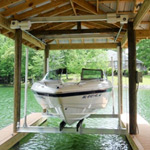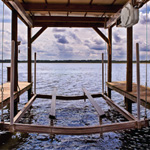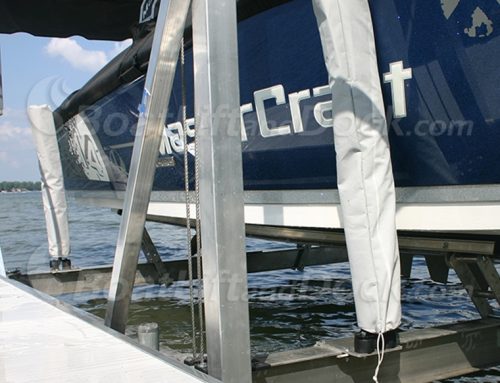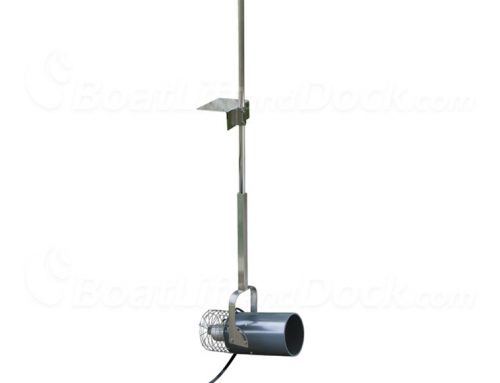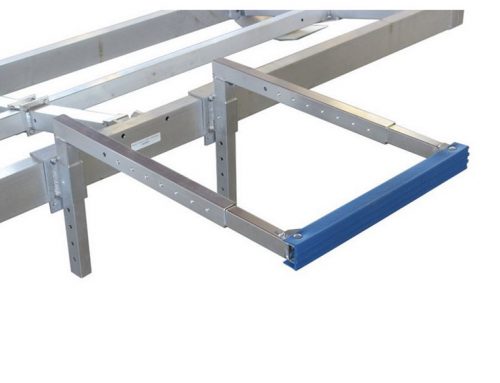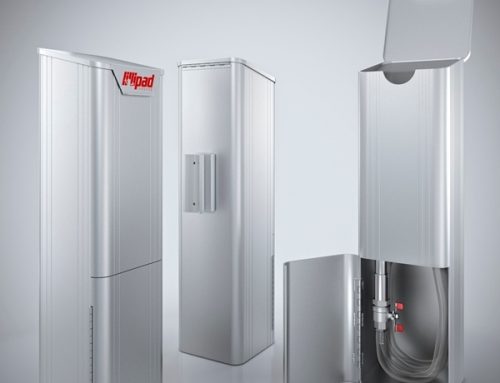The decision to install a boat house lift should not be taken lightly as the boat house structure and the lift require a very specific skill set to build and install. Listed below are a few of the considerations you will need to address.
- Do you want DC power or AC power?
- If AC power, you will need a Ground Fault Circuit Interrupter (GFCI).
- What size structure will you need, i.e. size and weight of your craft?
- What support framework will you need; v-hull, pontoon, flat bottom, etc?
- Are there any lake community requirements or restrictions?
Beyond the power supply, the structure and supports of the whole boathouse unit must be able to lift and support the watercraft; inadequacy in this area could lead to catastrophic failures, excessive damage and potential injury. A boat lift is a highly technical apparatus; combining winches, cables, pulleys, large beams, support framework, and either a DC or AC power source. Now add the fact that this large and complex, not to mention heavy, piece of equipment is designed to work in water, and lift another large and complex piece of equipment, i.e., your boat. The primary cause for pause, you might say, is that with a boathouse lift, the support framework for the lift unit is dependent on the in-place structure; the boathouse. So, before you proceed, make certain you have considered the following;
- The weight requirements are known and met.
- The dimensions of the structure are sufficient.
- All installations should be performed by professionals.
In this article we will discuss a few of the options available and some of their specific qualities, including their lift capacity, power source, and versatility.
Here are some of the available options:
High Tide Boat House Options:
This design features the sealed aluminum Hi-Tide Gear Drive® motor with a fast, efficient, and enclosed construction that gets the job done quickly and safely. The Hi-Tide® boat hoist is built to accommodate larger craft, extending its lift capacity up to 10,000 lbs and a beam width allotment spanning from 144″-156″. Listed below are some variations between the different sizes (lift capacity) available.
The 4000lb:
- Hi-Tide Gear Drive® Powered
- Has a 16′ Lifting Height with a lift rate of 40″ per minute
The 8000lb:
- Powered by one or two Hi-Tide® motors
- The lift height and speed vary depending on the motor configuration;
- single motor installed, the lift height is 8′ @ 20″ per minute
- dual motor configuration is 23′ @ 40″ per minute
The 10,000lb:
- Powered by a dual Hi-Tide Gear Drive®.
- Has a lift height of 13’@ 20″ per minute.
This lift design incorporates aluminum and stainless steel construction; giving this unit a lighter overall weight and a more reliable corrosion resistance than galvanized units. The one piece construction of the gear housing and gear box, give this unit a greater resistance to environmental conditions and a quieter overall operation; factors that can make standard flat-plate designs less desirable. This unit has a fast lift rate and features a standard manual toggle switch. The Hi-Tide can also be modified to accommodate pontoon and tritoon craft and the aluminum and stainless steel construction extends to the electric motor, pulleys, and structural components.
Shore Station Boat House Lifts:
Some of you fine people out there have specific needs when it comes to getting your watercraft in and out of the water; more than mere lift capacity you want speed in operation. A new boat house lift has arrived from Shore Station that, in the tradition of excellence they have established over the last 50 years, excels in function and form; easily outpacing their competitors and bringing speed, at last, to your boat house. Shore Station’s boat house lift system will raise your craft 8 feet in less than a minute; making it 4 to 5 times faster than the gear plate systems discussed above.
The key to the speed and effectiveness of the Shore Station boat house lift is their Flex Power® Hydraulic lift system. Unlike most other lift systems for boat houses, the Shore Station unit offers:
- A lift speed of 8′ in less than a minute.
- 24v DC power to operate one motor, which, in turn, activates two hydraulic pumps.
- Auto-leveling for more even, and quieter lift operation.
- Freedom from multiple motors and extensive and costly AC power installation.
With the use of hydraulic hoses the “reach” of the motor is extended and the lift rises evenly due to the simultaneous delivery of the fluid to the pumps. This simultaneous or “side-by-side” design achieves a feat missing in other boat house lift systems; namely auto leveling. This configuration of hydraulic pumps and motor gives the Flex Power®lift system a degree of synchronization not available on other boat house lifts that are lacking the dual power drives.
This unit is available in 4000lb and 6000lb options and features:
The Doozie is designed to lift your craft from above using either a single or a dual motor setup. The 3000/4000lb lifts use an AMS Heavy Hoist®
- A wireless remote and dock side switch operation as well as a one touch Auto-up operation.
- Aluminum and stainless steel construction.
- available solar power options.
- The instantaneous torque of DC power, and less draw, spiking, or tripping of breakers common in lift systems powered by electrical circuits.
The Shore Station Flex Power® Hydraulic boat house lift system is by far the premier boat house lift on the market and brings power, speed, safety, and reliability to your waterfront lifestyle.
Doozie:
If you are looking for an economically priced boat house lift that still gets the job done, check out the Doozie. The Doozie® boat house lift is available in 3000, 4000, and 6000lb lift capacities. The manufacturers have employed hot-dipped galvanized steel in the construction of this unit. This material will add years of life to your lift through an increased resistance to corrosion.The galvanization process is accomplished by dipping the steel in a zinc bath, which creates a thin protective layer that protects the steel from the corrosive effects of stray currents and other environmental factors such as mineral deposits. We will be bringing you more information on the various methods of preventing corrosion in our post on choosing the proper cables for your lift.
single side mounted, gear driven, flat plate lift motor, while the 6000lb unit uses two side mounted motors. The motor will lift your craft at a rate of 2.5 to 3 feet per minute with an overall lift of 10’.
The AMS Heavy Hoist motor is available in two cooling options:
- The Totally Enclosed Non-Ventilated (TENV), which uses convection cooling.
- The Totally Enclosed Fan Cooled (TEFC), which uses an external fan as part of the motor.
Both of these units allow the motor to operate smoothly and remain cool; functioning well in the unique conditions that marine environments present. This is an AC powered unit and will require 110v or 240v shore power with a GFCI. When it comes to the installation of the power service, including the GFCI, it would be best to allow a professional to do the work to ensure that all safety requirements have been met. For more information about the Heavy Hoist motor and some available options visit our site.
This lift unit comes complete with everything you will need to get going except the lumber for the hull bunks, which in most cases are cost prohibitive to ship and can be purchased locally. The cradle of the unit, where your craft will sit, consists of two I-beams that can be adjusted to support your specific hull design. The Doozie comes with 8’, 9’, and 10’ cradle widths and you can specify which one you require when you order your unit.
To recap, when you start thinking about having a boat house lift installed you definitely want to make sure that you get the right one. First you will have to decide how much you want to spend and your specific speed and operation requirements. Then, you need to verify your boat’s weight and beam width to ensure that the lift you choose can perform as needed and that your boat will fit on the cradle. Next, you will want to contact a contractor to build your boat house or inspect the one you already own. Finally, if you have shore power, or want a boat house lift that will be powered by AC, you will need to have an electrician install the circuits, and the GFCI, or inspect the installation.
Before building a boat house or purchasing a lift it is best to check with your regional or county authorities as the specific requirements for such a structure may indicate considerations not covered in this article.
© 2013 BoatLiftandDock.com

